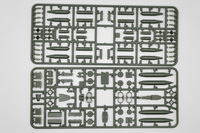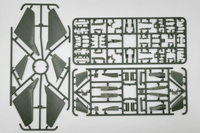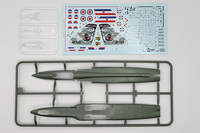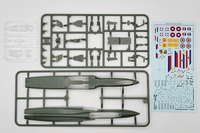
Litaki 1/72 J-22 & NJ-22 Orao Kits
By Chris Banyai-Riepl
Overview
The J-22 Orao came about from a joint project between Yugoslavia and Romania as a move to reduce dependency on Soviet aircraft during the Cold War. Started in 1970, the development of the J-22 (and IAR-93 in Romania) was conducted at both the Yugoslav Aeronautical Technical Institute and the Romanian Institute of Science and Technology and adopted license-produced versions of the Rolls Royce Viper jet engines and Martin Baker ejection seats. Armament remained on the Soviet side, with the GSh-23 cannon being the primary gun armament. The first single seater prototypes flew in 1974, with the two-seater prototype taking to the air in 1976. Both remained in service for decades, and both the J-22 and NJ-22 remain flying in the Serbian Air Force.
The Kits
Litaki is a new model kit company out of Ukraine, and they decided for their first kits to make something that has never been done in injection plastic (although a couple resin kits have been done in the past): the J-22 and NJ-22 Orao. These two kits, understandably, share the vast majority of parts (much like the real plane), with just the fuselage and clear sprues being different and the NJ-22 including one extra sprue for the additional second cockpit details. The parts are molded in a greenish gray plastic and feature some petite scribed lines throughout. A common photoetch fret provides some of the finer details, with a canopy mask and decal sheet with six options per kit rounding out the kit bits. The final bonus item included is a print of the boxtop artwork suitable for framing.
Starting with the cockpit area, this is built up from separate side console pieces, a two-piece instrument panel/forward bulkhead, and a rear bulkhead. The two-seat NJ-22 includes an extra middle bulkhead and two sidewall inserts for the rear cockpit. Details come in the form of photoetch, that then have matching decals to go over the top, which should result in a very good looking interior. The seats are a blend of plastic and photoetch, with cushions and seatbelts provided in the photoetch. There are also some decals to go on these as well, further adding to the realism. As these are standard Martin Baker ejection seats, should you wish to replace them with aftermarket examples there are plenty of choices out there that would work.
Sticking with the Western influence of the design, the engines are next, and these include a combination of photoetch and plastic parts, and here is the first stop in determining which path you want to take. The kit includes information and parts for all the different minor variants of the J/NJ-22, This includes an early and late version of the engine, so pay close attention to the instructions and make sure you choose the right parts for the scheme you want to do.
Still working on bits that go inside the fuselage, the next steps cover the landing gear wells. These are built up from multiple pieces, with the nose gear well having three pieces and each main gear well having five pieces. This may seem a bit complex, but this allows for very crisp detail to be molded and much easier detail painting of the separate pieces. With those together, you can then assemble the fuselage, inserting the cockpit parts and the separate instrument panel hood, the engine assembly, and the wheel wells. For the earliest J-22 option there are also photoetch strakes that get added at this point on the forward nose. With all that done, the upper fuselage can be glued to the lower fuselage. You might need some alignment help here, as the seam on the fuselage sides below the wing is a bit flexible. A couple of pieces of plastic card, or even just a piece or two of the kit sprue is all that will be needed to ensure a clean seam.
With the fuselage together, you now get to choose the appropriate exhaust end, with early and late variations, as well as the wing (split top and bottom), vertical fin (split left and right)and stabilizers (molded solid right and left pieces). The intakes are separate as well, with separate inside splitter plates, and the rear stinger above the exhausts is separate as well, split into right and left halves. Lots of pieces, but on quick glance it would appear that most of the seams will fall in logical places and with a bit of care in assembly, I think this will go together well enough to not need any filler, or very minimal at best. Two rear fuselage strakes and wing pylons finish the main assembly.
The landing gear is next, and this is a fairly complex gear setup. Starting with the wheels, these are split into right and left halves. Some may not like this method, but as long as you are careful to not sand down the mating surfaces, and take care with alignment, they should be fine. You’ll have to assemble five wheels, which seems like a lot until you get to the gear leg assemblies. The nose gear leg has five pieces, including the main strut, the retraction arm, two nose wheel arms, and a nose strut light piece. Each main gear assembly has seven pieces, which is definitely a lot. The payoff, though, is the completed landing gear is going to look pretty darn good. Add in the gear doors and speed brakes, and most of the build is finished.
Weaponry is next, and this kit comes with quite a bit. That’s a nice touch, as finding aftermarket weapons for this aircraft would be challenging. You get two styles of rocket pods, fuel tanks, bombs, and flare/chaff dispensers. The kit also has the cannons as separate pieces, one for each side. The NJ-22 has the option of no cannons. There are some final photoetch wing fences and various antennas and details, and these are ready for painting.
For both kits, the camouflage colors are all basically the same, consisting of a medium gray and dark green over a blue gray underside. Some have additional areas painted over with a gray green, but for the most part, they’re all similarly finished. The options for the J-22 include:
- 25103, Yugoslav Air Force, 1980s
- 25102, Yugoslav Air Force, Le Bourget 1987
- 25207, Serbia & Montenegro Air Force, 1998
- 25207, Republic of Srpska Air Force, 2006
- 25207, Serbian Air Force, 2007
- 25175, Serbian Air Force, 2021 (with tiger artwork on the tail)
For the NJ-22, the options include:
- 25504, Yugoslav Air Force, 1989
- 25504, Republic of Sprska Air Force, 1996
- 25526, Republic of Yugoslavia, 1999 (marked GTA-002 on the nose)
- 25525, Serbian Air Force, 2007 (marked IR on the nose)
- 25528, Serbian Air Force, 2012
- 25528, Serbian Air Force, 2023
The decals look to be well printed and include stenciling and other detail markings.
Conclusion
These are a great first set of kits for a company, and anyone interested in small air forces or small aviation manufacturers will be pleased with having these available. Hopefully we will see these return in new boxings for the Romanian IAR-93 variants, as those would add even more colorful camouflage schemes to an already interesting selection, and they are already working on their next subject, the 1/144 Tupolev Tu-22M3 bomber. Visit their website to keep up to date on their latest releases.





